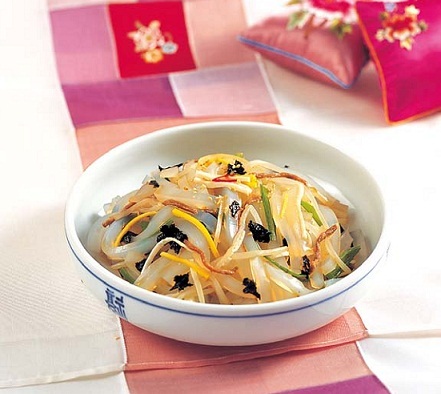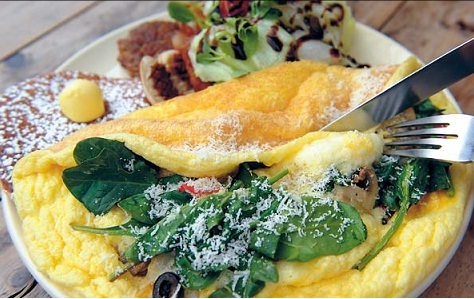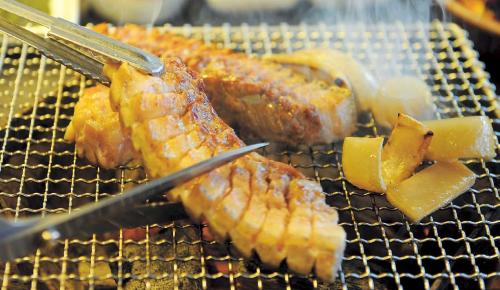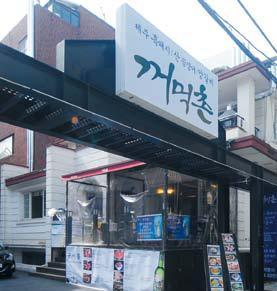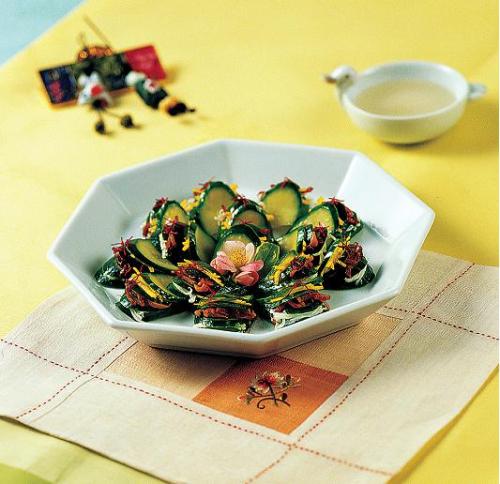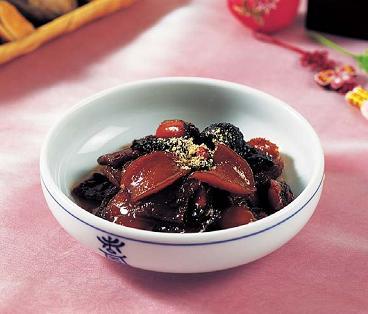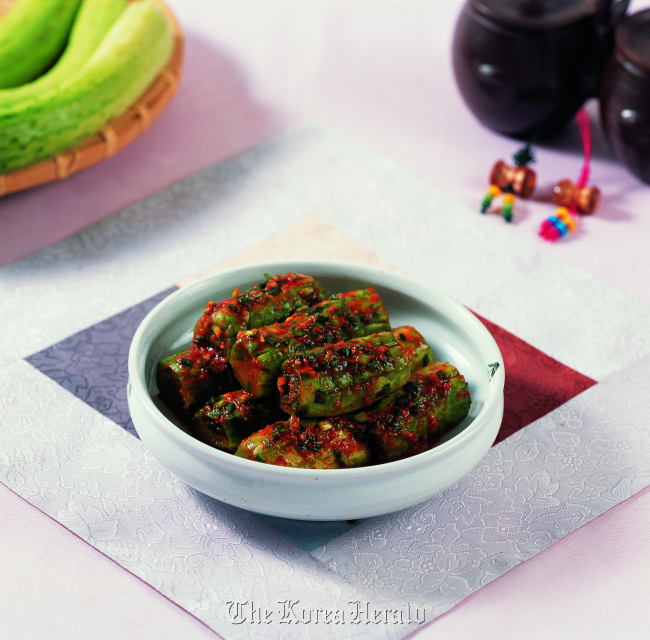Chefs use Asian cuisine as
spring board for fare that is outside of the boxIn the
world of cuisine, the term “fusion” was usually married to a set of regions;
giving the diner an idea of what to expect.
Shall we be having
Korean-Italian, French-Chinese or some other hybrid and hopefully a harmonious
meeting of several different cuisines tonight?
The experience was at
times sensational, where ingredients that one might never have imagined
appearing on the same dish did successfully meet, attracting press and buzz.
Fusion was trendy, hip and au courant.
Now, it seems to have surpassed
that initial wave of novelty. Fusion has grown deeper roots, making it something
of a norm, more of a natural result of an amalgam of a chef’s freewheeling and
increasingly globalized aesthetic.
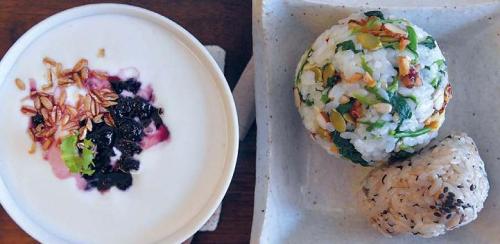 |
| E-bab’s
housemade yogurt with a mulberry “enzyme” drizzle (left) and chwinamul-nut and
tot-mushroom rice balls. Toasted nuts, slicd jujubes and sesame seed oil give
the chwinamul (aster scaber) jumeok bap its nutty and sweet richness, while rice
that has been cooked in mushroom water gives the tot (seaweed fusiforme) jumeok
bap its wonderful fragrance. (Lee Sang-sub/The Korea
Herald) |
E-bab, a tiny shop near
Changdeokgung in Gye-dong, is a prime example of what happens when fusion is the
outcome of an organic phenomenon, grown out of a creative process not confined
to a single region.
Though one might be initially tempted to define the
cuisine as Japanese-meets-Korean, a few trips will reveal that the winning
charms of the establishment’s star concoctions, like their housemade mulberry
yogurt, the nut-studded chwinamul jumeok bap and a tart omija lemonade-style
drink, stem from the owner-chefs’ willingness to simply step over any boundary,
with wonderfully tasty gusto to boot.
Run by two friends, Lee Myung-sook
and Lee Mi-sook, E-bab opened its doors in this quiet and charming neighborhood
in the winter of 2010 with the purpose of “making food that is good for you,”
said co-owner-chef Myung-sook, 50.
“We wanted to do something different,
healthy and unique,” she added. The end result was a menu primarily devoted to
jumeok bap (rice balls) that forked off into two categories ― Korean-style and
Japanese-style versions.
The key to their rice balls (known as onigiri
in Japan), however, is that E-bab’s chefs use those regions as a basic outline
for what they seek to achieve. Both Myung-sook and Mi-sook are willing to use a
variety of ingredients, regardless of ethnic origin, to create something that is
chock full of that yum factor.
Toasted nuts give the chwinamul (aster
scaber) jumeok bap its richness, punctuated by sweet slivers of jujube and
sesame seed oil. Honey mustard gives the tuna-and-mayo onigiri a spiced-up edge
that makes it utterly delicious.
Though rice ― at its glossy,
high-definition, big-kernel-rendered best ― is the leading lady of this eatery,
the yogurt topped with a mulberry “enzyme” drizzle, oatmeal and loaded with
slices of banana is one of E-bab’s highlights.
Housemade, pudding-like
in texture, cool and slightly tart, E-bab’s yogurt proves how a willingness to
take one’s menu anywhere can result in a great thing.
The same attitude
works well for Touch and Spice, a two-story restaurant in Seoul’s Saerosugil.
The spacious and lounge-like establishment specializes in what they refer to as
“creative mix Asian cuisine.”
“We apply a lot of Western techniques to
Asian ingredients,” clarified chef de cuisine Park In-oo, 35.
The
approach shines through in their wasabi cream chicken and mango. Fried chicken
is robed in a creamy sauce. The richness of the sauce is counterbalanced with
nose-clearing wasabi, while a whole, fresh mango half gives what Park refers to
as that key “sweet and sour” element. A small pinch of salt is served alongside
the mango.
“I guess you could say sprinkling salt over it adds body to
the fruit’s flavor,” he explained.
Despite their decidedly Asian banner,
Touch and Spice does not hedge all their bets on one stretch of territory alone.
The multi-page menu that includes everything from appetizers to main dishes to
sides, desserts and cocktails has the expansive reach of a quasi-nomadic
jetsetter.
The adventurous diner can sample everything from miso sauce
lamb steak to curry to tandoori paratha paired with a cream cheese dip or even
classic British fish and chips, which comes with something called onion
jam.
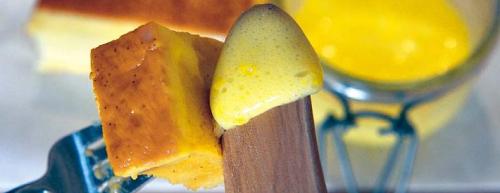 |
| A dab of lime
curd gives Touch and Spice’s sweet and decadent custard cake a tart punch.(Lee
Sang-sub/The Korea Herald) |
One of the
establishment’s stellar sweets, the Asian custard and lime curd dessert, sports
a distinctly European pedigree.
Riffing off the lemon curd traditionally
enjoyed at a British afternoon tea, Park reveals that lime was used instead
because he thinks it packs a piercingly tart punch that offsets the decadent
sweetness of the custard-topped sponge served with it.
Served in a cute
jam jar, diners are urged to pop off the lid, dip in a wooden knife and spread
the fragrant and sour curd over nibbles of warm, gooey, caramel-esque-edged,
custard-topped, dense, vanilla-speckled cake.
Come summer, Park revealed
that the menu will undergo a partial revamp. What to expect?
“Asian
barbecue,” said Park.
Details
E-bab; 104-49
Gye-dong, Jongno-gu, Seoul; (02) 744-2325; open from 11:30 a.m. to 8 p.m.
Mondays through Fridays, 11:30 a.m. to 6 p.m. Saturdays, closed Sundays; rice
balls cost 3,000 won to 5,500 won, rice ball sets cost 6,500 won to 7,500 won,
housemade mulberry yogurt 4,000 won, lemon omija tea 3,500 won.
Touch
and Spice; 541-4 Sinsa-dong, Gangnam-gu, Seoul; (02) 542-3009;
www.touchandspice.com; open from 11:30 a.m. to 11 p.m. daily; prix fixe meals
cost 33,000 won to 42,000 won, main dishes 17,000 won to 38,000 won, starters
and salads 13,000 won to 18,000 won, side dishes and snacks 4,500 won to 30,000
won, cakes and pudding 7,500 won to 10,500 won.
By Jean Oh (
oh_jean@heraldm.com)
